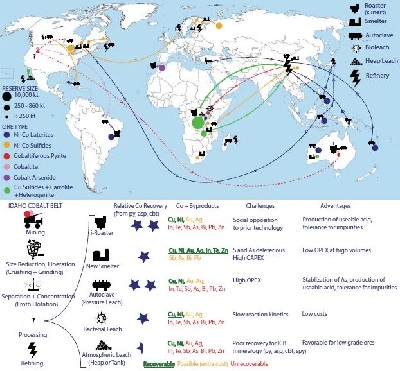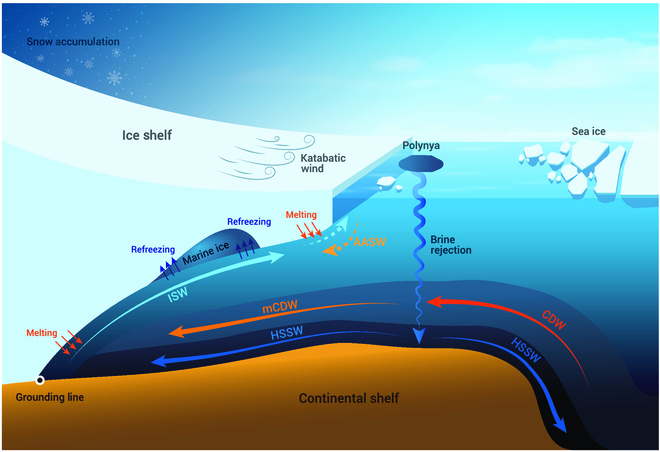Weather-related disasters and climatological extremes, including rivers bursting their banks and flooding as well as heatwaves and droughts, cause tragic loss of life and cost billions of dollars in property damage each year.
Tag: Earth Sciences
Alpine rock reveals dynamics of plate movements in Earth’s interior
Geoscientists analyze rocks in mountain belts to reconstruct how they once moved downwards into the depths and then returned to the surface.
Ancient landscape discovered beneath East Antarctic Ice Sheet
The research team, led by Durham University, UK, used satellite data and radio-echo sounding techniques to map a 32,000 km2 area of land underneath the vast ice sheet.
Finding Argoland: how a lost continent resurfaced
Geological puzzle solved after seven years of research
Vacuum cleaner-effect in fungi can hold nanoplastics at bay
Using micro-engineered soil models, researchers at Lund University in Sweden have investigated the effect of tiny polystyrene particles on bacteria and fungi.
Laser-based ice-core sampling for studying climate change
Researchers led by Yuko Motizuki from the Astro-Glaciology Laboratory at the RIKEN Nishina Center in Japan have developed a new laser-based sampling system for studying the composition of ice cores taken from glaciers.
Sustainable Lithium for Many Decades
On the way towards climate neutrality, Europe will need large amounts of lithium for battery storage systems. So far, however, its share in the worldwide lithium extraction volume has been one percent only.
Unknown Mechanism Impacting Earth’s Climate Revealed in New Study
In a recent study an unknown climate mechanism was discovered, offering insights into Earth’s past and present climate. The research focuses on the Cretaceous period when high atmospheric carbon dioxide levels prevailed.
Whale like filter-feeding discovered in prehistoric marine reptile
A remarkable new fossil from China reveals for the first time that a group of reptiles were already using whale-like filter feeding 250 million years ago.
Adding Snow to Estimates of Spring Flooding
By adding rain, snow, and rain-on-snow precipitation data to a background model, a new scheme pinpoints local flood risks in order to improve the design of small-scale hydrological infrastructure.

Why there are no kangaroos in Bali (and no tigers in Australia)
If you travel to Bali, you won’t see a cockatoo, but if you go to the neighbouring island of Lombok, you will. The situation is similar with marsupials: Australia is home to numerous marsupial species, such as the kangaroo and the koala. The further west you go, the sparser they become.
Apex predator of the Cambrian likely sought soft over crunchy prey
Biomechanical studies on the arachnid-like front “legs” of an extinct apex predator show that the 2-foot (60-centimeter) marine animal Anomalocaris canadensis was likely much weaker than once assumed. One of the largest animals to live during the Cambrian, it was probably agile and fast, darting after soft prey in the open water rather than pursuing hard-shelled creatures on the ocean floor.
Unveiling the secrets of liquid iron under extreme conditions
Iron is the most abundant element by mass on Earth. Despite being so common and well-studied, iron still manages to puzzle scientists by exhibiting electric and magnetic behaviors that are not fully comprehensible.

Cobalt mineralogy at the Iron Creek deposit, Idaho cobalt belt, USA: Implications for domestic critical mineral production
A new study published in Geology evaluates the potential for cobalt extraction from the Idaho Cobalt Belt (ICB) of east-central Idaho, using a detailed study of the Iron Creek deposit. The ICB hosts the second largest known domestic resource of the critical mineral cobalt, one of the key ingredients in many rechargeable batteries needed for the green energy transition.

Why Antarctic ice shelves are losing their mass and how it leads to global sea level rise
The Greenland ice sheet (GIS) and Antarctic ice sheet (AIS) contribute largely to global mean sea level (GMSL) changes, though the seas surrounding the Antarctic like the Bellinghausen-Amundsen Seas and the Indian Ocean sector are seeing significantly more warming than the rest of the marginal seas, with immediate noticeable effects on the mass balance (net weight of the glacier mainly accounting for ice gained by snow and lost by melting and calving) of the AIS.
Hidden ice melt in Himalaya: Study
A new study reveals that the mass loss of lake-terminating glaciers in the greater Himalaya has been significantly underestimated, due to the inability of satellites to see glacier changes occurring underwater, with critical implications for the region’s future projections of glacier disappearance and water resources.
One is bad enough: climate change raises the threat of back-to-back hurricanes
Getting hit with one hurricane is bad enough, but new research from Princeton University’s engineering school shows that back-to-back versions may become common for many areas in coming decades.
Researchers find several oceanic bottom circulation collapses in the past 4.7 million years
Antarctic bottom water (AABW) covers more than two-thirds of the global ocean bottom, and its formation has recently decreased. However, its long-term variability has not been well understood.
Scientists use satellite images to study the degradation of rangelands in Tanzania
East Africa’s iconic rangelands – under threat from climate change and human activity – have the potential to recover from repeated environmental shocks and degradation, a new study has concluded.
Complex subsurface of Mars imaged by Chinese rover Zhurong
Ground-penetrating radar from China’s Martian rover Zhurong reveals shallow impact craters and other geologic structures in the top five meters of the red planet’s surface.
Understanding Japan’s earthquakes: New insight into the relationship between slow slip events and the build-up and release of tectonic strain
The Japanese archipelago is actively undergoing seismic shifts due to interactions between the oceanic plate and the continental plate.
Meteorites reveal likely origin of Earth’s volatile chemicals
By analysing meteorites, Imperial researchers have uncovered the likely far-flung origin of Earth’s volatile chemicals, some of which form the building blocks of life.
Study sheds light on how human activities shape global forest structureStudy sheds light on how human activities shape global forest structure
Climate change and human activities strongly influence forests, but researchers have not fully understood the pervasiveness of these stressors and how they will shape future forest structure.
Nature conservation needs to incorporate the human approach
An international study led by the Institute of Environmental Science and Technology of the Universitat Autònoma de Barcelona (ICTA-UAB) stresses the need to apply a biocultural approach in nature conservation programs.
South Asian Black carbon aerosols accelerate loss of glacial mass over the Tibetan plateau
Black carbon aerosols are produced by the incomplete combustion of fossil fuels and biomass, and are characterized by strong light absorption.
Fertilizing the Ocean to Store Carbon Dioxide
Iron-based fertilizer may stimulate plankton to pull carbon dioxide from the ocean, driving a carbon-negative process.
Linking mass extinctions to the expansion and radiation of land plants
The Devonian Period, 419 to 358 million years ago, was one of the most turbulent times in Earth’s past and was marked by at least six significant marine extinctions, including one of the five largest mass extinctions ever to have occurred.
Using monsoons of the past to predict climate conditions of the future
The North American southwest has been suffering through weather extremes in recent years ranging from searing heatwaves and scorching wildfires to monsoon rainfalls that cause flash floods and mudslides.
Scientists identify the highest-ever recorded volcanic plume
Using images captured by satellites, researchers in the University of Oxford’s Department of Physics and RAL Space have confirmed that the January 2022 eruption of the Hunga Tonga-Hunga Ha’apai volcano produced the highest-ever recorded plume.
Protected areas buffer climate change for biodiversity
Climate change is emerging as a top threat to biodiversity according to the latest Global Assessment Report on Biodiversity and Ecosystem Services.
Scientists bring back Earth’s memory with mountaintop ice
Humans are fascinated by our planet’s distant past.
New Scottish fossil sheds light on the origins of lizards
A fossil discovery from Scotland has provided new information on the early evolution of lizards, during the time of the dinosaurs.
Global warming at least doubled the probability of extreme ocean warming around Japan
In the past decade, the marginal seas of Japan frequently experienced extremely high sea surface temperatures (SSTs).
How Pitt biologists are making fieldwork more equitable
In a new publication, a team of biologists share their process for crafting a manual for field research that prioritizes safety for researchers from marginalized groups.
Magma and ice
Let’s pretend it’s the Late Cretaceous, roughly 66 to 100 million years ago.
Researchers find crucial evidence to explain anomalously fast convergence between India and Asia in Mesozoic
Closure of the Neo-Tethys Ocean and the subsequent formation of the Tibetan Plateau is one of the most significant tectonic events on Earth.
Ancient source of oxygen for life hidden deep in the Earth’s crust
Scientists at Newcastle University have uncovered a source of oxygen that may have influenced the evolution of life before the advent of photosynthesis.
Study reveals evidence of historic climate change leading to conflict in Yucatan, Mexico
Scientists have discovered that a lengthy drought led to the collapse and abandonment of the prehistoric Mexican city of Mayapan, demonstrating evidence of a connection between climate change and civil unrest among the ancient Maya.
The bigger the temperature change, the larger the extinction event, reveals researcher
A professor emeritus at Tohoku University has unearthed evidence pointing to a strong relationship between the magnitude of mass extinctions and global temperature changes in geologic times.
Ancient South American dust helps reveal new clues about the future of the Earth’s climate, researchers say
Dust that was deposited at the foot of the Andes Mountains in Argentina over the last 1.15 million years helps explain how wind patterns have shifted and could offer clues of what is to come as the Earth’s climate changes, according to new research by a team from South Carolina and Arizona.
The Possibility of Carbon Emissions Peak in China by 2030 Depends on the GDP Growth Rate
This research is done by Professor Weidong Liu, Associate Professors Zhipeng Tang and Mengyao Han, and Dr. Wanbei Jiang from the Institute of Geographical Sciences and Natural Resources Research, Chinese Academy of Sciences.
China’s terrestrial carbon sequestration in 2060 could offset 13–18% of energy-related peak CO2 emissions
President Xi of China announced in September 2020 that China will “aim to have CO2 emissions peak before 2030 and achieve carbon neutrality before 2060”.
Volcanoes at fault if the Earth slips
The 2016 Kumamoto earthquakes shocked inhabitants of the western island of Kyushu, causing hundreds of casualties and serious damage to vital infrastructure.
Lesser known ozone layer’s outsized role in planet warming
New research has identified a lesser-known form of ozone playing a big role in heating the Southern Ocean — one of Earth’s main cooling systems.
Rapid glacial advance reconstructed during the time of Norse occupation in Greenland
The Greenland Ice Sheet is the second largest ice body in the world, and it has the potential to contribute significantly to global sea-level rise in a warming global climate.
Volcanism drove rapid ocean deoxygenation during the time of the dinosaurs
Ocean deoxygenation during the Mesozoic Era was much more rapid than previous thought, with CO2 induced environmental warming creating ocean ‘dead zones’ over timescales of only tens of thousands of years.
Fungus That Tastes Just Right
PNNL researchers are forming a clearer picture of how plant matter is transformed in the microbial gardens created by leaf-cutter ants
Muddied waters: sinking organics alter seafloor records
The remains of microscopic plankton blooms in near-shore ocean environments slowly sink to the seafloor, setting off processes that forever alter an important record of Earth’s history, according to research from geoscientists, including David Fike at Washington University in St. Louis.Fike is co-author of a new study published in Nature Communications.
Decisions, Decisions: Climate Change and Water
PNNL’s Framework for Assessment of Complex Environmental Tradeoffs (FACET) is designed to navigate and rigorously evaluate competing environmental, economic, and social impacts to help make decisions more equitable. In an example scenario prepared using publicly available data, FACET was applied to predict tradeoffs facing the Colorado River and to balance competing demands of river flow and temperature, along with withdrawals for cities, crop irrigation, and power generation.
Iceland’s Fagradalsfjall is erupting. This UB expert helps predict where lava may go
Mattia de’ Michieli Vitturi, a geology faculty member and a mathematician, uses computational modeling to help officials in Iceland understand where lava may flow BUFFALO, N.Y. — The eruption of Fagradalsfjall on Iceland’s Reykjanes Peninsula, with lava emerging from multiple…